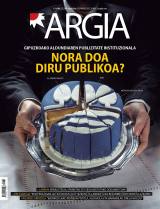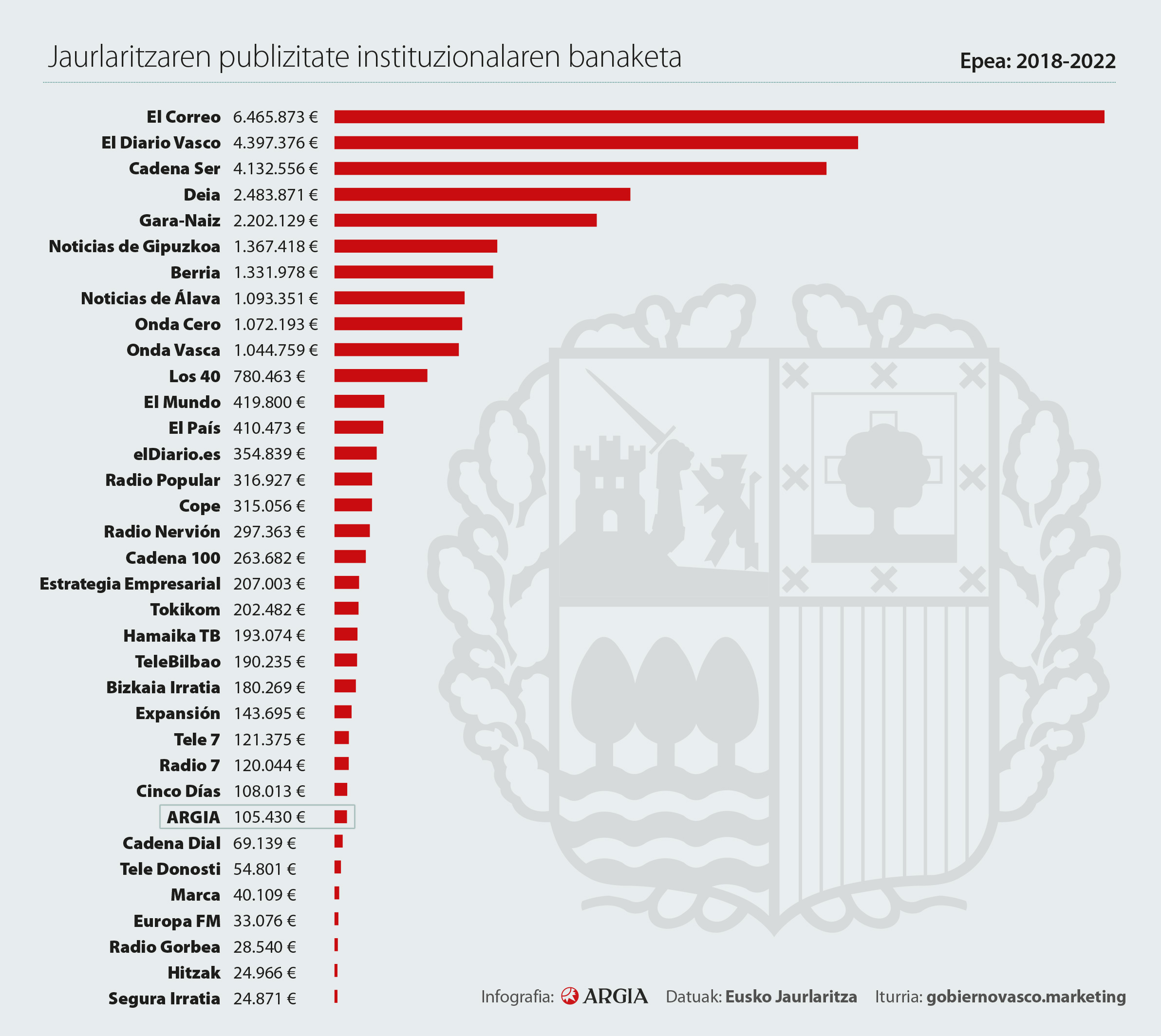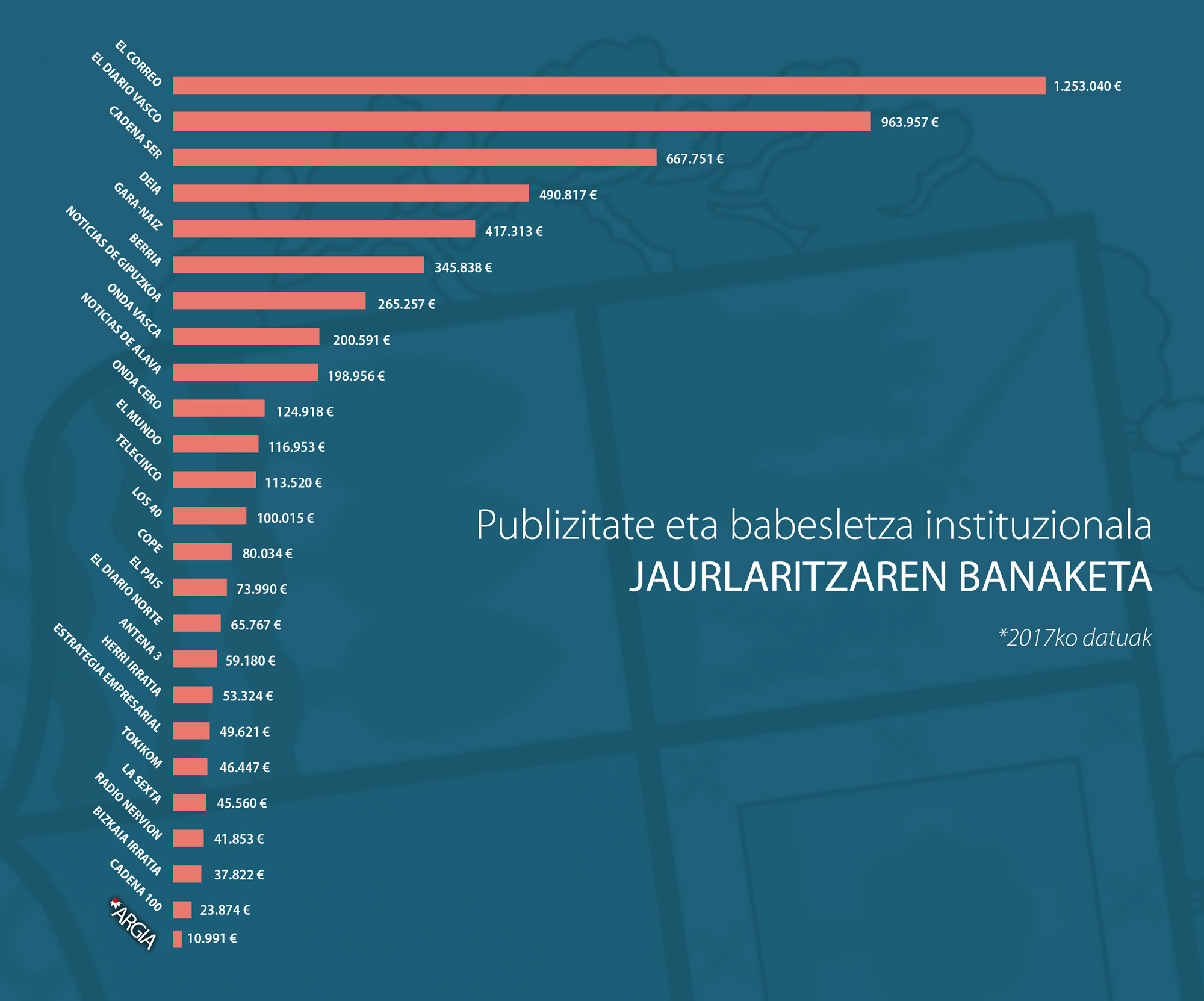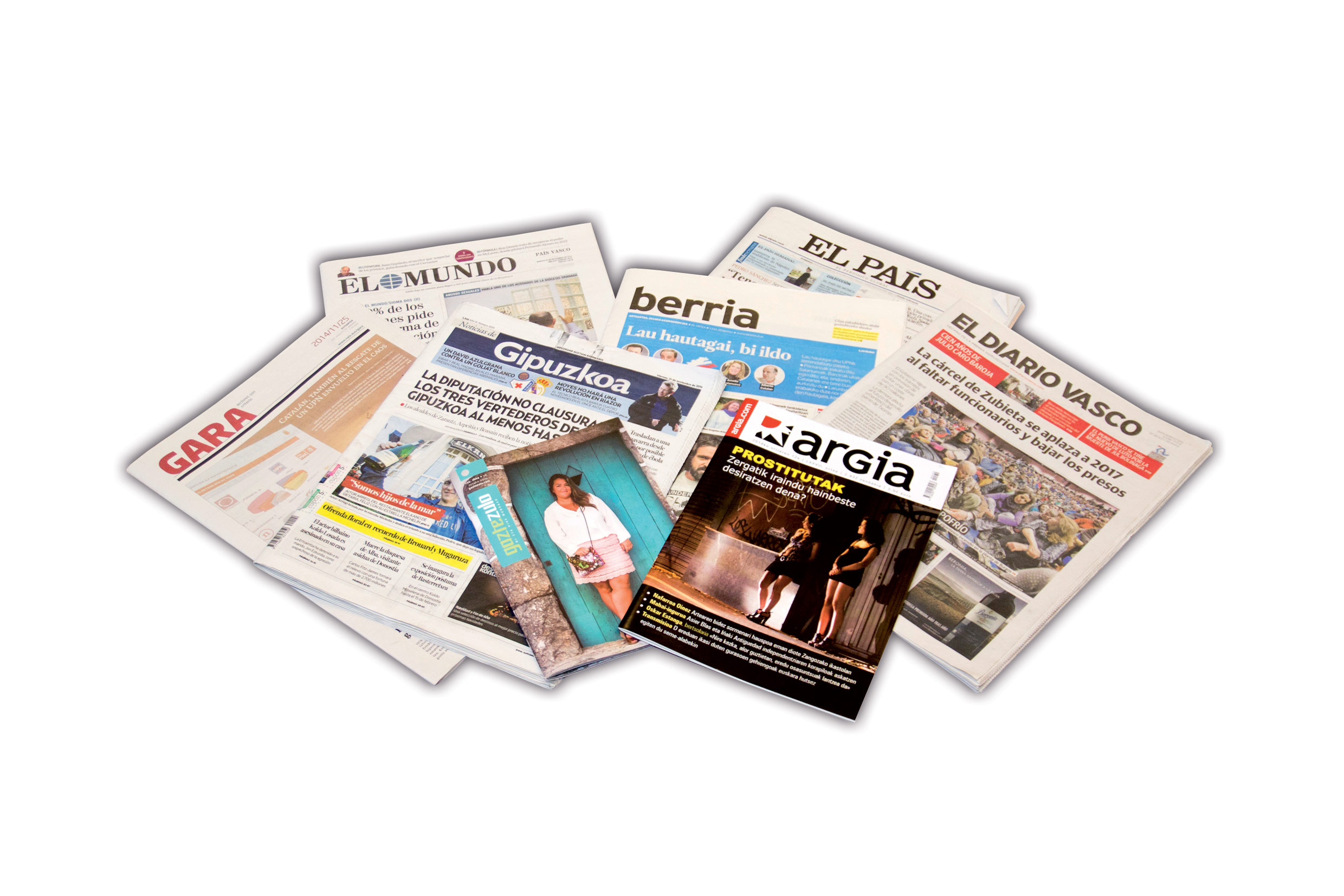Political instrument to influence the media
- Which means of communication does it receive more money through institutional advertising and sponsorships and which are the ones left out? What are the distribution criteria? ARGIA has analysed the case of the Diputación de Gipuzkoa, which has begun to provide public data, which is the only one. As an aperitif: last year the Diputación allocated the largest amount of money to the daily El Diario Vasco, 399,075 euros, and for comparison, 4,293 euros to ARGIA, almost a hundred times less. Far from the knowledge of the public, behind is the opaque system that moves hundreds of thousands of euros from public money.
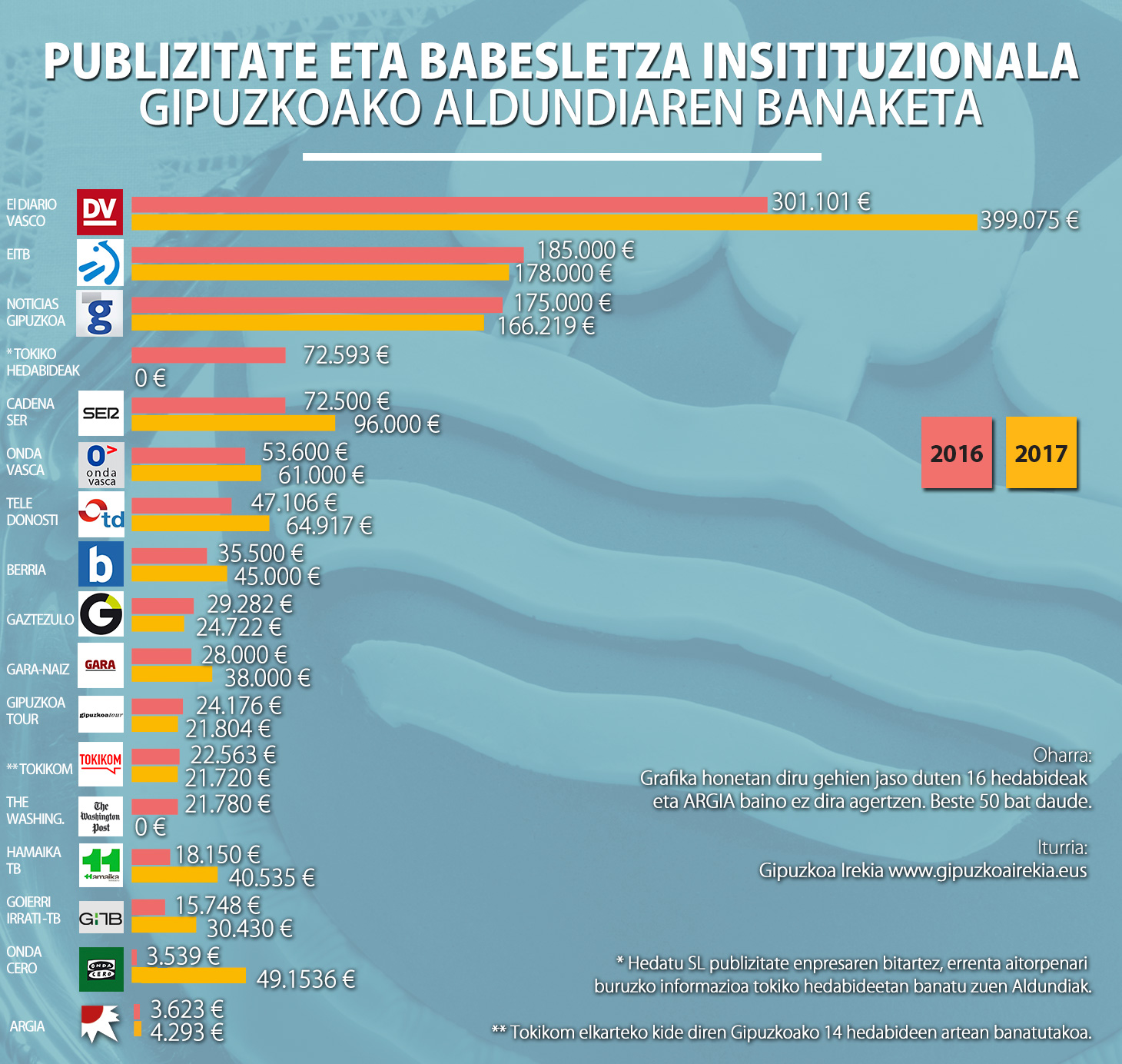
Every year, the public institutions of Euskal Herria distribute millions among the media in exchange for disseminating the information generated by the institutions (advertising) or sponsoring with public money certain works that the institutions consider appropriate (sponsorship).
This report aims to publicize the distribution and the way in which the Provincial Council of Gipuzkoa does so. In the main infographic the distribution of advertising and sponsorship made by this institution in the years 2016 and 2017 is available. These data have been made available to the public for the first time and the Council of Gipuzkoa is today the most transparent institution on this issue. All data are public, available on the website of Gipuzkoa Irekia. In Bizkaia, Álava and Navarre, citizens cannot know today how much public money these institutions spend on the media through public advertising. Data are also not made available in municipalities where the highest numbers are mobilised. That is why the report is based solely on Gipuzkoa data.
Expenditure on the distribution of advertising and institutional sponsorship is divided into two main blocks: Expenditure on advertising campaigns and minor contracts. The work of several weeks has been to examine the documents and to arrive at figures. In some cases the concepts of the contracts are inaccurate, the dates of the notice and the contract do not appear and the actual divisions made through the subcontracts do not appear. Documents also contain other types of contracts (e.g. communication services), but the only ones we have taken into account are contracts directly related to advertising or media sponsorship. The list is completed with the identification of the expenses in the public documents and the comparison of the documents requested by EH Bildu in the General Boards. However, for the reasons set out above, it is possible that in some cases the number is not entirely accurate, so we want to present a photograph as correct as possible. Finally, we have compared our results with first-hand information from different media before presenting them.
The Diario Vasco, owner and owner
of El Diario Vasco, received at least EUR 399,075 in 2017, through institutional advertising and contracts from the Diputación de Gipuzkoa. It is the Gipuzkoan newspaper that receives the most public money each year. In total, El Diario Vasco y Teledonosti received 463,992 euros from Vocento. In the second place are Noticias de Gipuzkoa y Onda Vasca, which make up the Noticias de Gipuzkoa group, which have received 277,219 euros; EiTB has paid 178,000 euros to the public media and 96,000 euros to the radios that make up the SER group. Not counting bilingual EiTB, the other three report almost in their entirety in Spanish.
69% of the money allocated to advertising and sponsorship by the Provincial Council of Gipuzkoa in 2017 has been allocated to the media mainly in Spanish, the other 13% has been allocated to EiTB’s bilingual radio and television stations financed from public funds and 18% to Basque media. In the Basque media as a whole, last year the local media received EUR 112,535, 45% of the money allocated to the Basque media. For example, the money raised by all the media in Basque in 2017 has been more than collected by the two News Group media.
The obsolete and diffuse criterion is the one
determined by the Foral Rule of 6 April 1994 on the distribution of institutional advertising by the Council of Gipuzkoa. Although the media and media landscape has changed considerably, the text adopted 24 years ago is the only reference. The rule has a manifest deficiency: it only refers to the written press, leaving aside radio, television or the Internet. Moreover, the first article that points out which means of communication the norm is addressed says that it is simply “the newspapers of Gipuzkoa”. However, this has been the reference to justify the allocation of funds that has been given in recent years.
The general objectives of the Foral Standard are as follows: “That Basque citizenship is not discriminated against by language [sic], that the right to information and plurality of information, proportionality are guaranteed, in order to respect free competition between the media and efficiency”. To this end, he stressed that "arbitrariness and flexibility must be put aside".
The rule divides the annual budget into four blocks. 8% of the institutional advertising is guaranteed for the “Basque newspaper” – among them Euskaldunon Egunkaria, Euskaldunon Egunkaria – and “on the day when more than one Basque newspaper was published, it should be given similar or equal treatment”. 37% of the budget is distributed “on an equal footing among the newspapers published in Gipuzkoa”. The other 37% is determined to distribute it according to the “expansion figure”. And the remaining 18% goes to “other media” taking into account “the territorial scope and recipients” of advertising.
The Director-General for Communication of the Provincial Council of Gipuzkoa, Elene Arrazola Soto, has been consulted by ARGIA and has pointed out that the Foral Standard for the distribution of advertising is a standard. “Respect for plurality and honesty with that [media] diversity is the main criterion, as stated by the foral norm.” However, as can be seen from his own words, other criteria that are not mentioned in the Foral Standard are also followed. On the one hand, he stressed that when distributing institutional announcements and subsidies to the media in Basque "special treatment is given to the local media". On the other hand, “they prioritize local media or editions that, depending on the audiences, offer specific information about the territory”.

They do not comply with the Foral
Standard There are data showing that the Provincial Council of Gipuzkoa breaches the Foral Standard. Berria does not receive 8% of the budget – in 2017 it received 3% –, 37% of the budget is not distributed equally among all the media that are published in Gipuzkoa. More than a dozen people received less than 1,000 euros in 2017.
In addition, regarding the remaining 37% to be distributed according to the scope of the data, the data do not match. For example, according to data from the Office of Justification of Dissemination, known as OJD, based in Madrid, between 2010 and 2017 the sale of specimens of El Diario Vasco comes in permanent decline. A daily average of 71,948 units was sold in 2010, while 48,949 units were sold in 2017, according to the same source. For example, in 2017 the Diputación has donated 100,000 more in advertising and sponsorship than in 2016: 25% increase.
If the scope of the means of distribution of public money is taken as a criterion, the case of the newspaper Noticias de Gipuzkoa raises a number of doubts. In 2013, OJD granted an average of 5,411 copies per day and in 2016 an average of 4,291 units. The amount received from this sale shows that the distribution is not proportional: The Diario Vasco received in 2017 a total of 399,075 euros for the sale of 48,949 copies (2016 data), and Noticias de Gipuzkoa has achieved a total of 166,219 euros with 4,291 copies.
If the scope of the money received by 'Noticias de Gipuzkoa' justifies this, with a proportional distribution, 'Gara' and 'Berria' should receive tens of thousands more euros
This is confirmed by the 2016 data provided by the Spanish Sociological Research Centre (CIS). Gara has calculated an average of 35,000 daily readers, followed by Berria, with 29,000; readers of the News journal of Gipuzkoa totaled 26,000 according to the CIS in 2016. In other words, if the scope justifies most of the money raised by News from Gipuzkoa, with a proportional distribution, they should receive tens of thousands of euros more than the Gara and Berria newspapers currently collect.
The CIS data also highlights the gap between advertising and the “scope” received by Onda Vasca from the News Group. According to this organization, Onda Vasca was the ninth most widely heard radio station in Gipuzkoa so far this year. Regarding advertising distributed in 2017, Onda Vasca has received more money than Onda Cero or Cadena 100, to quote two.
The data provided by the Provincial Council of Gipuzkoa reflect the advertising expenditure by departments. The department of the Deputy General is by far the one that devotes the most money, but also the other departments carry out advertising campaigns. Data shows that the fact that there is one or the other at the head of the department leads to changes. The presence of the Chain SER in the departments in which it is in the hands of the PSE-EE is higher, and in general, the presence of the media in Euskera is lower than in the rest. By far, the Diario Vasco is the one that receives the most money in all sections.
Proportionality?
In 2017, three media companies received 62% of the total budget: Vocento 33%, Grupo Noticias 16% y EiTB 1%
“It is necessary to ensure that the standard guarantees the right to information and respects the plurality of information and the law of mutual competition.” This complicated phrase is quoted textually in the preamble to the Foral Norm. Data, however, show significant differences in distribution. In 2017, three media companies received 62% of the total budget, almost two-thirds of all advertising and institutional sponsorship: Vocento 33% –El Diario Vasco y Teledonosti–, Grupo Noticias 16% –Noticias de Gipuzkoa y Onda Vasca– and EiTB 13%. The remaining 38 per cent has been distributed among 48 media outlets around the world.
In 2016 the distribution was also similar. These three groups accounted for 61 per cent of the total budget: Vocento un 28%, Grupo Noticias un 18% y EITB un 15%.
The "scope" of the media in the
distribution of advertising is of decisive importance to the Member. With the advent of the Internet, however, it is very difficult to quantify the real scope of the media: Who counts how many people come through private networks like Whatsapp, Twitter, Facebook or Youtube? Data from the Spanish organization OJD and the Google Analytics statistics of the websites are only taken into account for the calculation of the “scope”. Therefore, public institutions do not quantify the expansion of social networks, which are the strength of some media. In addition, the economic resources of each medium and the path taken in the past are not taken into account. With some questions, the latter is better understood.
Should the media owned by the multinationals and the media whose workers are the owners be rewarded at the same level?
Should the media owned by the multinationals (in the case of Vocento, for example, BBVA is the majority shareholder) and the working-owned media such as ARGIA be at the same level? Competition in itself is unbalanced, between a medium backed by a large bank and one that keeps up with its resources. The former is guaranteed daily dismissal, provided that investors consider it appropriate for their interests. The second, on the other hand, must get funding for each issue it publishes. If the institutions have to protect the plurality of information, what is the point of the current advertising policy?
Nor is the historical heritage of the media taken into account when distributing money. Although it is essential to understand the current “reach capabilities”. The Basque Journal in Gipuzkoa and El Correo in Bizkaia and Álava, and in short, the hegemony and power of the regional newspapers of Vocento in several provinces of the Spanish State cannot be understood without the role played by these media in the Franco regime and the privileges they accumulated.
Without prejudice to the problems of calculation of scope, the conversion of scope into the main criterion of distribution is an effective means to perpetuate the status quo of the media, as well as the hegemony of Castilian to the detriment of the Basque Country. By not considering the work done by some media on social networks, they benefit from many means and harm others.
Advertising is an
essential source of economic revenue for the survival of many media, and above all, sponsorship and public advertising. The economic relationship between political power and private companies is an area that must be monitored with great caution in any democracy. And in the case of the media that have to guarantee freedom of information, even more so. Because journalism is a factor that can question its independence, economic and political, necessary for it to be a journalism.
“If you distribute money arbitrarily you are buying wills, you are harming the right to information. Freedom of expression is seriously impaired if the press is not related to freedom; and freedom of the press cannot be fully developed without fair rules.” Eldiario.es Ignacio Escorial, director of the media, talks about the media landscape in the Spanish state at a conference organized by Amnesty International. “We have a plural press, almost all Spaniards can find a press that shares their opinions and points of view; but what we do not have is a fair field for the press,” he said. According to the September 2017 chronicle of Eldiario.es, “he expressed it by referring to the control of political and economic actors over information. In particular, this sentence referred to institutional advertising, the distribution of public money with arbitrary and opaque criteria.”
In this field in Euskal Herria there is still a long way to go. In addition to the lack of transparency in the distribution of advertising, there is a lack of specific criteria. Both issues are easy to resolve if there is a will on the part of the political parties and if the media provides citizens with close monitoring of the use of public money.
We must join the other institutions.
This amount of money that the Council of Gipuzkoa allocates to the media through advertising and sponsorship is just one example. To have the full picture, we have to take into account the money that comes from the advertising of the other public institutions – of the other Members who use the same criteria – of many public companies such as ETS, of municipalities, of some companies that receive a lot of public money, of the Basque Government, and in the case of some media from the Government of Spain and from the entities to their orders.
Thus, the business groups that sell the most in the Basque Country are newspapers, television and radio, which each year receive millions of public funds without citizens knowing them through advertising, sponsorship, technical works and subsidies.
Three representative examples
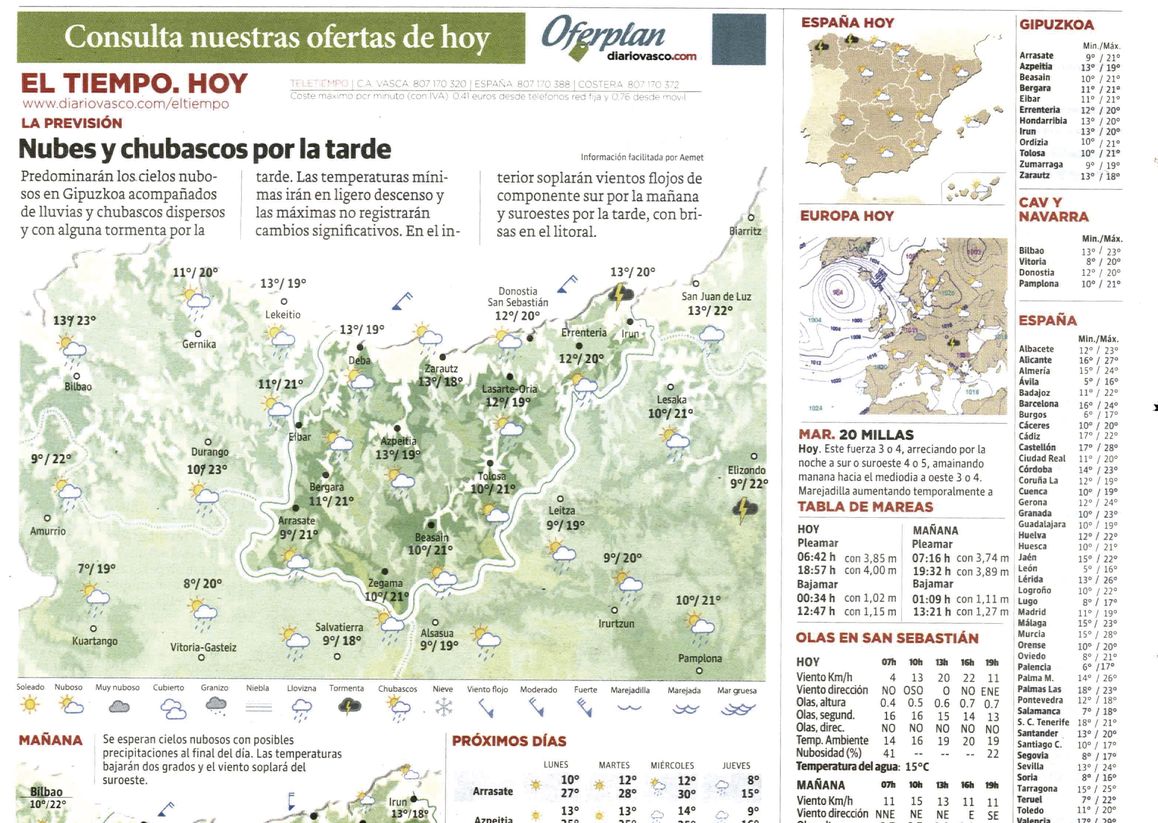
by El Diario Vasco in 2017, the Diputación supports the DV weather information page, El Tiempo Hoy. The Diputación made three payments to the newspaper of Vocento for an amount of 4,800 euros, with a total of 14,400 euros in 2016 and other as many in 2017.

SER Chain (Radio Eibar, Radio Irun and Radio San Sebastián) for providing information on beaches. In Onda Vasca, for the sponsorship of the beaches information section, made three payments of 3,025 euros, a total of 9,075 euros.

published eight supplements in 2017 under the concept of sponsorship. One of them was published in Sud Ouest on culture and tourism (1,180 euros) and seven others in El Diario Vasco. The cheapest was that of Bioterra, with a cost of 3,630 euros, of the Idiazabal cheese, 3,640; thereafter, the health cheese, 4,235, the cybersecurity cheese, 4,950 and another, 9,570 euros. The Department of the Environment, with public reports from the incinerator, is considerably more expensive: The ticket price was EUR 17,545, while the ticket price was EUR 21,671.
Espainiako Gardentasun Kontseiluak zortzi ministeriori iragarkien datuak publiko egin behar dituztela exijitu ostean, salaketa jarri dute Auzitegi Nazionalean erabakia ez betetzeko.
Hedabide euskaldunak biltzen dituen Hekimen elkarteak bilera eskatu dio Gipuzkoako Foru Aldundiari, erakunde horrek iragarritako publizitate instituzionalaren beherakada aztertzeko. 2015eko aurrekontuarekin alderatuta, erdira jaitsiko du euskarazko hedabideetako publizitatea... [+]









